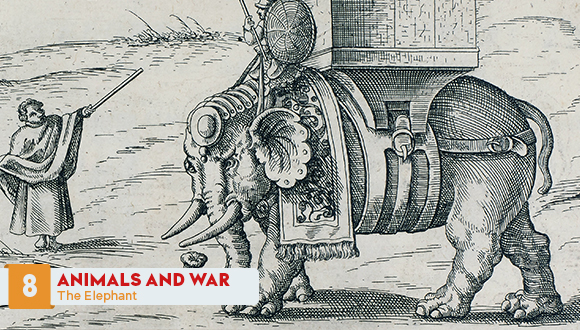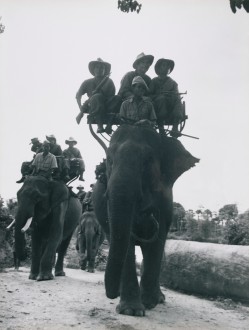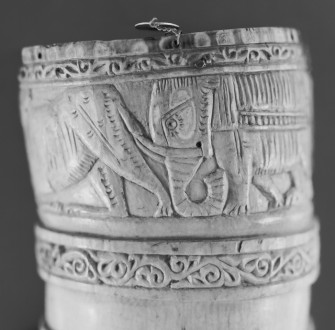
Badge of the 4th Caterpillar Company of the French 84th Artillery Regiment designed by François Mourgues (1884-1954) ca. 1917. © Paris, musée de l’Armée, dist. RMN-GP Émilie Cambier
« De l’exercice de la sixiesme classe, asçavoir de batailler avec des Élephants ». The above reproduction of the war-elephant is taken from La Milice Romaine avec la traduction de Flave Vegece en langue Françoise by Johann Jacob von Wallhausen (c. 1580- c. 1627), printed in 1616. Wallhausen reproduced the artwork for another book by Godescalcus Stewechius (1557-1588), printed in 1585 and linked to the De Re Militari (Concerning Military Matters), a treatise written at the end of the fourteenth century or at the beginning of the fifteenth century by Publius Flavius Vegetius Renatus, also known as Vegece. The first edition of De Re Militari is a non-illustrated compilation of Greek and Roman military treatises. It was reprinted on numerous times, mostly during the Renaissance, with illustrations greatly inspired by the then latest innovations both in archaeology and numismatic. However, considering the war-elephant’s size, morphology and plate armour along with the number of combatants sitting on the tower, we can easily assume that the artist played with proportion and reality. © Paris, musée de l’Armée, Dist. RMN-GP / Pascal Segrette
“Elephant-shaped aerostat”. Article and photograph published in Le Miroir on 7 October 1917. © Paris, musée de l’Armée
“Elephants on patrol“. Photograph number 5 of the report “The elephant section and the mounted platoon of the 3rd Battalion of Cambodian Chasseurs”, taken by Robert Bouvet in Indochina in August 1952, for the Press Information Service of the French Army. © Paris, musée de l’Armée, Dist. RMN-GP / image musée de l’Armée
The Elephant
In service
These wild animals are captured and then trained according to their assigned functions. In a military context, pachyderms — from the Greek pakhudermos meaning thick-skinned — were used in the fields of military engineering such as construction and development of structures and for transporting equipment, troops and the wounded. They could also be used as a weapon on the battlefield or during a siege. The war elephant is captured when it is at least 20 years old. Feeding this animal is rather costly since it needs at least 200 kg of fodder per day. He can live up to the age of eighty. Indians, Persians, Chinese, Carthaginians, Romans, etc., have employed elephants for military purposes since Antiquity.
The Stampeding Pachyderm
To influence the course of a battle, the war elephant must create surprise by causing fear and terror to the horse, the enemy’s traditional mount. Although less mobile than the horse, the elephant can charge at up to 20 mph towards the enemy and its impact force is enormous. Besides, it is also trained to sweep all that lay in its path and grab its opponents with his trunk and throw them into the air or simply trample them … The psychological effect is undeniable. However, even when tamed for warfare, the elephant remains a wild animal and only obeys its mahout. When an elephant is injured or loses its driver, it can become uncontrollable, causing tremendous damage in the opposition’s ranks by killing a large number of men, but it can also turn around and do likewise to men of its own army.
Precious material
After a gestation period of 20 to 22 months, a female elephant gives birth to a single calf and nurses it during a period of 36 to 48 months. Around 100 BC, it only took a decade to exterminate the entire elephant herd living of North Africa. The animals were hunted not only for the precious and coveted ivory of their tusks, but also to supply the enormous demands from the Roman circuses where they were used for spectacle.
Always in Service
War elephants were occasionally used by the Parthians (247 B.C. – 224 A.D.) and, later on, by the Sassanids (224 – 651 A.D.) on a much larger scale. Under the Sassanids, war elephants were dressed in battle armour and bore a large crenelated light-weight howdah strapped on their backs used as a safe shooting platform. Later on, men sitting in the howdah were provided with firearms. During battle, the infantry served the elephant as protection for its legs and belly. War elephants also served on the battlefields of Southeast Asia. During the Sino-French War, the Vietnamese used them against the French in 1885. In India, the Royal Engineers employed them in the Indian Army until 1895. The pachyderm was still employed by the military during the Second World War, for example the celebrated heroic mission of the convoy of elephants which took part in the rescue of hundreds of refugees fleeing the Japanese invasion of Burma in 1942. Elephants were instrumental for transport, evacuation or loading airplanes, and particularly useful as auxiliaries to engineers for building runways, roads, bridges and clearing the obstacles placed by the enemy…







Ajouter un commentaire